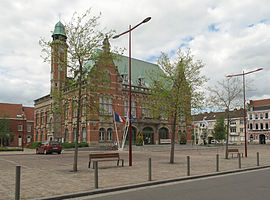Orchies
Orchies | |
|---|---|
 The town hall | |
| Coordinates: 50°28′32″N 3°14′42″E / 50.4756°N 3.245°E | |
| Country | France |
| Region | Hauts-de-France |
| Department | Nord |
| Arrondissement | Douai |
| Canton | Orchies |
| Intercommunality | CC Pévèle-Carembault |
| Government | |
| • Mayor (2020–2026) | Ludovic Rohart[1] |
Area 1 | 10.92 km2 (4.22 sq mi) |
| Population (2022)[2] | 8,390 |
| • Density | 770/km2 (2,000/sq mi) |
| Time zone | UTC+01:00 (CET) |
| • Summer (DST) | UTC+02:00 (CEST) |
| INSEE/Postal code | 59449 /59310 |
| Elevation | 22–49 m (72–161 ft) (avg. 30 m or 98 ft) |
| 1 French Land Register data, which excludes lakes, ponds, glaciers > 1 km2 (0.386 sq mi or 247 acres) and river estuaries. | |
Orchies (French pronunciation: [ɔʁʃi]; Dutch: Oorschie) is a commune in the department of Nord in the Hauts-de-France region of French Flanders, northern France.[3] Its inhabitants are called Orchésiens.
Orchies is the biggest town of the Pévèle. It is especially known for its Musée de la chicorée, the museum of chicory.
Orchies is twinned with Kelso in the Scottish Borders area of the United Kingdom.
The French Romantic composer Clément Broutin (1851–1889) was born in Orchies. The politician Valérie Létard (1962-) was born in Orchies.
Transport
Orchies railway station is served by TER Hauts-de-France. The station is situated on a junction between the Fives–Hirson railway and the Somain–Halluin railway.
Population
| Year | Pop. | ±% p.a. |
|---|---|---|
| 1968 | 5,972 | — |
| 1975 | 5,756 | −0.52% |
| 1982 | 5,587 | −0.42% |
| 1990 | 6,945 | +2.76% |
| 1999 | 7,472 | +0.82% |
| 2007 | 8,379 | +1.44% |
| 2012 | 8,196 | −0.44% |
| 2017 | 8,828 | +1.50% |
| Source: INSEE[4] | ||
Heraldry
 |
The arms of Orchies are blazoned : Argent, a lion sable armed and langued gules, in dexter chief a crosslet ?patty? within an orle gules.
|
See also
References
- ^ "Répertoire national des élus: les maires" (in French). data.gouv.fr, Plateforme ouverte des données publiques françaises. 13 September 2022.
- ^ "Populations de référence 2022" (in French). The National Institute of Statistics and Economic Studies. 19 December 2024.
- ^ INSEE commune file
- ^ Population en historique depuis 1968, INSEE
External links




